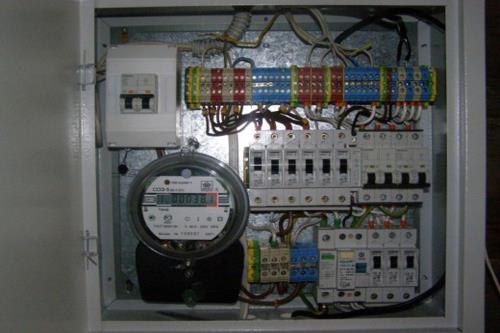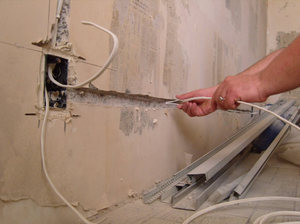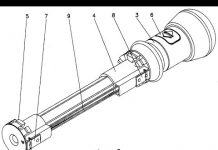Repairing electrical wiring in an apartment is a rather complicated event that requires attentiveness, accuracy and knowledge of their business from the contractor. With the right approach and following all the recommendations of a professional electrician, any problem can be quickly resolved.
During work, it is very important to follow the safety rules. They will not only save life, but also help maintain health.
VIDEO
Replacing the wiring yourself is a rather difficult task. In this article we will try to figure out what an RCD is and how to make an electrical wiring with our own hands.
The right lighting will help you transform any room and create a cozy atmosphere in it. We will talk about the secrets of lighting design, as well as how to make lighting with our own hands in this article.
Installing a light switch is not so difficult. There is no need to call the master. Read this article and you can do the installation of the light switch yourself.
Repair in an apartment is very often accompanied by the replacement of wiring and sockets. This section provides all the information on this topic, what types of sockets exist, how to install and correctly connect different types of sockets.
Is it realistic to do electrical wiring in the apartment with your own hands? - Quite, but for this you need to study a lot of information.But after that, you can easily and quickly eliminate any problem in the electrical network of your apartment.
If you are going to lay the electrical wiring yourself, you need to develop a wiring diagram for the apartment. Outlets, switches, lamps, junction boxes, power panel and wiring should be indicated.
Replacing the electrics in the apartment is mandatory during a major overhaul, as well as in the event of a serious breakdown. How to do it yourself and do it right? All the answers are in this article.
An electrician in an apartment with his own hands, at first glance, is not an easy task, but after reading the articles on our website, you will figure everything out and make the wiring, sockets, switches and lighting with your own hands.
Electricity bills received at the end of the month literally take half of the salary. What can be the way out of this? - Naturally, start saving by reducing the daily electricity consumption in the house to the maximum.
Modern technologies are increasingly helping to make our life more comfortable and safe. In this article, we will talk about a residual current device and learn how to connect an RCD in your apartment.
Everything about electrical accessories: from the choice of sockets and switches to wiring.
Even 15 - 20 years ago, the load on the power grid was relatively small, but today the presence of a large number of household appliances has provoked an increase in loads at times. Old wires are far from always able to withstand a heavy load and over time there is a need to replace them. Laying electrical wiring in a house or apartment is a matter that requires certain knowledge and skills from the master. First of all, this concerns knowledge of the rules for wiring wiring, the ability to read and create wiring diagrams, as well as wiring skills. Of course, you can do the wiring with your own hands, but for this you must adhere to the rules and recommendations set out below.
All construction activities and building materials are strictly regulated by a set of rules and requirements - SNiP and GOST. As for the installation of electrical wiring and everything related to electricity, you should pay attention to the Rules for the Arrangement of Electrical Installations (abbreviated as PUE). This document prescribes what and how to do when working with electrical equipment. And if we want to lay electrical wiring, then we need to study it, especially the part that relates to the installation and selection of electrical equipment. Below are the basic rules to follow when installing electrical wiring in a house or apartment:
Wiring work begins with the creation of a project and a wiring diagram. This document is the basis for future house wiring. The creation of a project and a scheme is quite a serious matter and it is better to entrust it to experienced specialists. The reason is simple - the safety of those living in the house or apartment depends on it. Services to create a project will cost a certain amount, but it's worth it.
Those who are used to doing everything with their own hands will have to, adhering to the above rules, as well as having studied the basics of electrical engineering, independently make a drawing and calculations for network loads. There are no particular difficulties in this, especially if there is at least some understanding of what an electric current is, and what are the consequences of careless handling of it. The first thing you need is a legend. They are shown in the photo below:
Using them, we make a drawing of the apartment and outline the lighting points, installation locations for switches and sockets. How many and where they are installed is described above in the rules. The main task of such a scheme is to indicate the place of installation of devices and wiring. When creating a wiring diagram, it is important to think in advance where, how much and what kind of household appliances will be.
The next step in creating a diagram will be the wiring to the connection points on the diagram. It is necessary to dwell on this point in more detail. The reason is in the type of wiring and connection.There are several such types in total - parallel, sequential and mixed. The latter is the most attractive due to the economical use of materials and maximum efficiency. To facilitate the laying of wires, all connection points are divided into several groups:
lighting of the kitchen, corridor and living rooms;
toilet and bathroom lighting;
power supply of outlets in living rooms and corridor;
power supply to kitchen sockets;
power supply of the socket for the electric stove.
The above example is just one of many lighting group options. The main thing to understand is that if you group the connection points, the amount of materials used is reduced and the circuit itself is simplified.
Important! To simplify wiring to the outlets, the wires can be tucked under the floor. Overhead lighting wires are laid inside the floor slabs. These two methods are good to use if you don't want to gouge walls. In the diagram, such wiring is marked with a dotted line.
Also in the wiring project, the calculation of the estimated current strength in the network and the materials used are indicated. The calculation is performed according to the formula:
where P is the total power of all used devices (Watt), U is the voltage in the network (Volts).
For example, a kettle of 2 kW, 10 bulbs of 60 W each, a microwave oven of 1 kW, a refrigerator of 400 W. The current strength is 220 volts. As a result (2000+ (10x60) + 1000 + 400) / 220 = 16.5 Amperes.
In practice, the current in the network for modern apartments rarely exceeds 25 A. Based on this, all materials are selected. First of all, this concerns the cross-section of the wiring. To facilitate the selection, the table below shows the main parameters of the wire and cable:
The table shows the most accurate values, and since quite often the current strength can fluctuate, a small margin will be required for the wire or cable itself. Therefore, it is recommended that all wiring in an apartment or house be made of the following materials:
VVG-5 * 6 wire (five cores and a cross-section of 6 mm2) is used in houses with three-phase power supply to connect the lighting panel to the main panel;
VVG-2 * 6 wire (two cores and a cross-section of 6 mm2) is used in houses with a two-phase power supply to connect the lighting panel to the main panel;
VVG-3 * 2.5 wire (three cores and a cross-section of 2.5 mm2) is used for most of the wiring from the lighting panel to junction boxes and from them to sockets;
VVG-3 * 1.5 wire (three cores and a cross-section of 1.5 mm2) is used for wiring from junction boxes to lighting points and switches;
VVG-3 * 4 wire (three cores and a cross-section of 4 mm2) is used for electric stoves.
To find out the exact length of the wire, you will have to run a little with a tape measure around the house, and add another 3-4 meters of stock to the result obtained. All wires are connected to the lighting panel, which is installed at the entrance. Circuit breakers are mounted in the shield. Usually these are RCDs for 16 A and 20 A. The former are used for lighting and switches, the latter for sockets. For the electric stove, a separate RCD of 32 A is installed, but if the power of the stove exceeds 7 kW, then an RCD of 63 A.
Now you need to calculate how many sockets and junction boxes are needed. Everything is pretty simple here. It is enough to look at the diagram and make a simple calculation. In addition to the materials described above, various consumables will be required, such as electrical tape and PPE caps for connecting wires, as well as pipes, cable ducts or boxes for electrical wiring, and socket outlets.
There is nothing super complicated in wiring work. The main thing during installation is to adhere to safety rules and follow the instructions. All work can be done alone. From the installation tool, you will need a tester, a hammer drill or grinder, a drill or screwdriver, wire cutters, pliers, and a Phillips and slotted screwdrivers. The laser level will not be superfluous. Since without it it is quite difficult to make vertical and horizontal markings.
Important! When carrying out repairs with the replacement of wiring in an old house or apartment with hidden wiring, you must first find and, if necessary, remove the old wires. For these purposes, a wiring sensor is used.
We start the installation with the markup. To do this, using a marker or pencil, we put a mark on the wall where the wire will be laid. At the same time, we observe the rules for placing wires. The next step is to mark the places for the installation of lighting fixtures, sockets and switches and a lighting panel.
Important! In new houses, a special niche is provided for the lighting panel. In old ones, such a shield is simply hung on the wall.
Having finished with the markings, we proceed either to the installation of the wiring in an open way, or to the chipping of the walls for hidden wiring. First, using a perforator and a special crown nozzle, holes are cut out for the installation of sockets, switches and junction boxes. For the wires themselves, grooves are made using a grinder or a perforator. In any case, there will be a lot of dust and dirt. The depth of the groove of the groove should be about 20 mm, and the width should be such that all the wires can easily fit in the groove.
As for the ceiling, there are several options for resolving the issue of placing and securing the wiring. First, if the ceiling is suspended or suspended, then all the wiring is simply fixed to the ceiling. The second - a shallow strobe is made for wiring. Third - the wiring is hidden in the ceiling. The first two options are extremely simple to implement. But for the third one will have to make some explanations. In panel houses, floors with internal voids are used, it is enough to make two holes and stretch the wires inside the floor.
Having finished with the gating, we proceed to the last stage of preparation for the installation of the wiring. The wires must be pulled through the walls to bring them into the room. Therefore, you will have to punch holes with a punch. Usually such holes are made in the corner of rooms. We also make a hole for the wire plant from the switchboard to the lighting panel. Having finished chipping the walls, we begin the installation.
We start with the installation of the lighting panel. If a special niche was created for it, then we place it there, but if not, then we simply hang it on the wall. We install an RCD inside the shield. Their number depends on the number of lighting groups. The assembled and ready-to-connect shield looks like this: there are zero terminals in the upper part, grounding terminals at the bottom, automatic machines are installed between the terminals.
Now we put the wire VVG-5 * 6 or VVG-2 * 6 inside. From the side of the switchboard, the electrical wiring is carried out by an electrician, so for now we will leave it without connection. Inside the lighting panel, the lead-in wire is connected as follows: the blue wire is connected to zero, the white wire to the upper contact of the RCD, and the yellow wire with a green stripe is connected to ground. We connect the RCDs in series with each other at the top using a jumper from the white wire. Now we turn to open wiring.
We fix ducts or cable channels for electrical wiring along the lines outlined earlier. Often, with open wiring, the cable channels themselves are trying to be placed near the baseboard, or vice versa, almost under the very ceiling. We fix the wiring boxes with self-tapping screws with a pitch of 50 cm. We make the first and last holes in the box at a distance of 5 - 10 cm from the edge. To do this, we drill holes in the wall using a puncher, drive a dowel inside and fix the cable channel with self-tapping screws.
Other distinguishing features of exposed wiring are sockets, switches and distribution boxes. All of them are hung on the wall, instead of being embedded inside. Therefore, the next step is to put them in place. It is enough to attach them to the wall, mark the places for fasteners, drill holes and fix them in place.
Next, we proceed to the wiring.We start by laying the main highway and from the sockets to the lighting panel. As already noted, we use the VVG-3 * 2.5 wire for this. For convenience, we start from the connection point towards the dashboard. At the end of the wire we hang a label indicating what kind of wire it is and where it comes from. Next, we lay the VVG-3 * 1.5 wires from the switches and lighting devices to the junction boxes.
Inside the junction boxes, we connect the wires with PPE or carefully insulate. Inside the lighting panel, the main wire VVG-3 * 2.5 is connected as follows: brown or red core - phase, connected to the bottom of the RCD, blue - zero, connected to the zero bus at the top, yellow with a green stripe - ground to the bus at the bottom. With the help of a tester, we "ring" all the wires in order to exclude possible errors. If everything is in order, call an electrician and connect to the switchboard.
The hidden wiring is quite simple. A significant difference from the open only in the way of hiding the wires from the eyes. Otherwise, the actions are almost the same. First, we install the lighting panel and the RCD machines, after which we start and connect the lead-in cable from the side of the distribution panel. We also leave it unconnected. An electrician will do this. Next, we install distribution boxes and socket boxes inside the niches made.
Now let's move on to the wiring. We are the first to lay the main line from the VVG-3 * 2.5 wire. If it was planned, then we lay the wires to the sockets in the floor. To do this, we put the VVG-3 * 2.5 wire into a pipe for electrical wiring or a special corrugation and lay it to the point where the wire is output to the sockets. There we place the wire inside the groove and put it into the socket. The next step will be to lay the VVG-3 * 1.5 wire from the switches and lighting points to the junction boxes, where they are connected to the main wire. We insulate all connections with PPE or electrical tape.
At the end, we call the entire network with a tester for possible errors and connect it to the lighting panel. The connection method is similar to that described for open wiring. Upon completion, we seal the grooves with plaster putty and invite an electrician to connect to the switchboard.
Laying an electrician in a house or apartment for an experienced craftsman is quite easy. But for those who are poorly versed in electrical engineering, you should use the help of experienced specialists from start to finish. This, of course, will cost money, but this way you can protect yourself from mistakes that can lead to a fire.
VIDEO
Do you want to change the wiring in the apartment with your own hands? - It's possible! To do this, it is not necessary to have a valid electrician permit, or an electrician diploma. It is enough to be an electrician in the shower, and have a little technical education and understanding of what you are dealing with. If you do not have enough practical experience, but you really want to change the wiring yourself - this article is for you.
First you need to draw wiring diagram of your apartment ... You don't need to be an engineer to do this, because you don't need a sophisticated linear circuit in accordance with GOST. It is enough to draw a schematic drawing "by hand". The wiring diagram is needed in order to properly spread the cable around the apartment, and calculate its approximate amount, as well as determine the load on each future line.
Draw where you will have sockets and switches. At the same time, take into account what household appliances you will include in them, how many and what lamps you will use.
It is not recommended to hang more than 8-10 sockets on one line. Since all the sockets in the line are through-type, then with each subsequent outlet there is a possibility of weakening the contact. Especially do not make many outlets on one loaded line, for example, in the kitchen, it is better not to save money and extend two lines to the kitchen.
Determine the required number of lines and the expected load on them.It is better to divide the lines by zones, for example: kitchen sockets, corridor sockets, bath sockets, room 1 sockets, lighting, etc.
In order for electrical appliances to work without overloading the network, the cable of each line must be of the appropriate section. And if, on the same line (for example, to the kitchen), there are several consumers (and it will be so), then it is necessary to calculate their total capacity and leave safety margin of the cable , that is, select the desired section (wire thickness). The power of all household appliances is always indicated by the manufacturer. For example: a 40W incandescent lamp, and a 6000W hob, etc.
In order not to bother with calculations, follow one simple rule. - For outlet lines, use a copper cable with a cross-section of 2.5 sq. Mm, for all lighting 1.5 sq. Mm, and for a hob or instantaneous water heater 4 sq. Mm - and you will be fine!
Each device (consumer) has its own declared maximum power, measured in watts.
The cable must be three-core (phase, zero, earth). Zero is always blue, earth is yellow or yellow-green, phase is any other color ... If you change the wiring, do not save on material - always take a cable with a third core (with grounding), because all modern devices have an additional protective terminal, and protective automatics work only with the use of grounding .
It is best to use a VVG-ng cable to replace the wiring. You can, of course, use NYM or PVS, but the advantages of the VVG cable over others are obvious. Firstly, VVG does not need to be crimped with sleeves (soft must be crimped). And secondly, it is smaller and flat, which allows you to make smaller strobes, and it is possible to push the cable into a thin slot (3mm for a three-core cable with a cross section of 1.5mm)
Always take only a cable in accordance with GOST! For example, an excellent cable is Gostovsky VVG ng. This is a very important point in preparation for replacing the wiring! You can save money on automatics or sockets (you can always change them), but do not save on the cable - take a good one.
Determine at what height the sockets and switches will be located, the easiest way is to measure the lines of sockets and switches from the ceiling, because the floors in apartments are often crooked. For example, if the height from floor to ceiling after repair is 250 cm, and you want to raise the sockets by 30 cm, measure 220 cm from the ceiling.If there are several sockets and switches in one group, draw a horizontal line along the level and put a mark every 7 cm (box size 71mm), the same applies to vertical groups.
For lovers of standards, so that it was "like everyone else" or "how they do" - remember they don't exist! There are requirements for kindergartens, kindergartens and schools where sockets and switches are installed at a height not lower than 160 cm. ... Everything else, especially at your home, you can do as you like. For example, some make rosettes in the slopes of windows or even in the floor.
Usually, wiring in apartments is carried out either on the floor or on the ceiling. There are other options, such as cable routing under skirting boards or ducts.
Lighting lines, in any case, are laid behind a stretch or false ceiling, if they are not planned to be done, then the ceiling must be channeled. And since the monolith of the ceilings shading is strictly prohibited , you need to apply a layer of plaster to the ceiling, which will allow you to hide the cable without damaging the monolith. We highly do not recommend shaping the ceiling on your own, since you need to know the technology of correct shaping, so that later the whole house does not collapse.
In cases where plastering of the ceiling is not planned, experienced craftsmen find voids in the slab of the monolith with the old cable, and tighten a new one in its place.
Crown for concrete 70mm or 68mm (perforator attachment), holes are drilled for socket outlets. A groove cutter or a grinder is used to cut the grooves for laying the cable. The grooves in the walls should be strictly vertical rather than horizontal or diagonal. The lines from the sockets to the panel are laid in the floor screed or along the ceiling.
If the ceilings are not wooden, then according to the PUE (electrician's bible), cable laying without corrugation is allowed! There is also no need for a floor screed in corrugation, the most important thing is a high-quality cable with good insulation in accordance with GOST! Save money on corrugation, if you do not have drywall or wood (or other flammable materials), then corrugation is not needed!
When you start hammering in the walls, do not forget about the law. It is possible to make noise with a puncher in apartment buildings only at a strictly defined time; each region of the Russian Federation has its own procedures. For example, in Dagestan it is necessary to obtain permission from the elders, in Moscow they simply call the police without talking, and in Taganrog they begin to hammer back. Better to start work on weekdays from 9 to 19 , with a break for lunch from 13 to 15 .
Before you start chasing, it is highly desirable that the walls and ceilings be plastered with a leveling layer of plaster. Firstly, you will not have any further problems with the final installation of the sockets, since all sockets will be flush with the wall, and not recessed into it (which happens when they are installed before the walls are plastered). And secondly, the slitting will be much faster, since in some places it will not be necessary to cut the monolith.
Check in advance the places where you will chase, so as not to touch the communications - old wiring and plumbing pipes. If you cannot determine where the old wiring goes, call an electrician , or just turn it off in the shield (if you are going to change it all). For the convenience of work - make yourself a temporary carrier (extension cord).
The hole for the sockets is channeled to the full depth of the crown. In order to quickly drill a hole in concrete, mark a circle with a crown, after which any drill, no less than the depth of the crown, drill as many holes as possible around the circumference. After that, chipping with a crown will go much faster, you can say - it will go smoothly. When hitting the reinforcement, it is best to use another crown, in extreme cases, you can knock it down with a spatula. It is better to use a more powerful puncher (do not forget about the neighbors and the police).
Strobes for cable laying go from the socket to the floor or ceiling. It is necessary to lower the strobe down so that the cable calmly lies in the screed and does not stick out in the corner, so you need to know the thickness of the future screed, the same with ceilings. It is best to have a chaser with a vacuum cleaner for these cases, but in extreme cases, you can do with a grinder, with a diamond disc on a stone. In the case of a grinder, take care of your health, put on a respirator and goggles. Close all windows and doors to isolate dust from entering adjacent rooms.
It is not difficult to lay the cable on the floor, it is enough to grab it to the floor in any way so that it does not float up when they are doing the screed. Usually, the cable is laid along the walls (at a distance of 10-15 cm from the wall), so that later you know exactly where the cable goes.
It is worth noting that it is better not to lay the cable under doorways! To lay the cable on the floor, it is better to make through holes between rooms. Otherwise, there is a possibility of damage to the cable when installing the interior sills.
Laying the cable in the groove is also not particularly difficult. You can fix the cable in the groove using dowel clamps or ordinary alabaster (stucco). Alabaster quickly hardens, so it is also convenient to use for mounting socket outlets. But before smearing the strobes with them, it is necessary to remove dust from them and moisten them with water.
If the cable is securely fixed in the groove and does not protrude anywhere, the grooves can be covered with ordinary plaster mixture, this will save a lot of time.
Soldering (or junction boxes) are necessary for switching (connecting) wires in them and branching lines, for example, for a switch.
Today professional electricians will tell you that there is no need to install junction boxes in well-timed apartments ! They can play a trick on your harness. In the event of a short circuit, otrania, neighbors flooded, etc., you will need access to this very junction box. It is easy to refuse junction boxes - do all the switching in socket boxes! This requires DEEP socket boxes , in which all switching for lighting will take place. Usually, deep sockets are made for light switches, but if switching is needed to branch out the outlet lines, then deep sockets are also installed under the sockets.
The most budget-friendly option is to install all the circuit breakers on the staircase in a common shield, where your old automatic machines and a counter are already located. To do this, it is necessary to lead all the cables into the driveway. If you want a shield in your apartment, then you need to choose a suitable place for it.
Built-in or overhead flap, it's up to you. Built-in looks more aesthetic, but it is easier to mount a consignment note. All lines from the apartment go to the shield, and already one thick cable goes from it to the driveway, the cross-section of such a cable must be at least 6 mm, that is, a three-core cable for example VVG 3 * 6.
Each separate line has its own automatic protection device, with a rating depending on the cable cross-section. It is impossible to insert more than two lines into one machine according to the rules, if you are trying to power more than three lines from one machine, you must install a special branching bus.
Today, there are many ways to protect electrical wiring, even at the household level. The most necessary condition is the installation of overload and short-circuit protection circuit breakers (conventional single-pole circuit breakers). It is also recommended to install an additional residual current device - RCD (current leakage protection).
RCDs are best installed on the line of high-risk zones: wet rooms, children's rooms. There is no need to install one common RCD for the whole apartment! One common RCD is installed only with the aim of saving. The consequences of such savings are complex diagnostics of a fault in the event of a leak, + the whole apartment is left without light when it is triggered. On some lines, for example, on lighting or street lines, an RCD is not installed.
Installation of additional types of protection is already a luxury: thermal relay (protection against cable heating), lightning protection, stabilizer or protection against voltage surges (saves from 380V), fire alarm, etc.
One of the most crucial moments is the assembly of the shield. If you use a soft cable, then before inserting the wire into the machine, it must be crimped (to increase the contact area). In single-module machines, only phase wires are inserted (phase L marking - can be of any color except blue and yellow), all the rest (zero N blue, ground PEN yellow-green) are inserted into their buses. When using RCDs or difavtomats (machine and RCD "in one bottle"), the neutral wire is inserted into its groove (marking N - neutral, blue. The common phase connects all the machines to each other, for this, instead of jumpers from wires, it is better and more reliable to use special combs.
For all connections in the switchboard, it is very important to use wires of the appropriate cross section, that is, it is best to separate the phases and zeros along the machines with a cable with a cross section of 4 mm2 or 6 mm2. Also, after tightening all cables and combs in the machines, it is necessary to check the reliability of their clamping. Since it very often happens that the wire simply does not fall into the clamp, or it is bad to hold on to it.
Sockets and switches are installed last, after a clean finish (painting or wallpapering). The most important rule of good editing is good contact!
Most of the sockets in your apartment are loop-through, that is, through them a cable goes through a loop to each subsequent outlet.In order to avoid problems with wiring in the future, firstly, do not buy cheap sockets (for example IEK), they have a very bad (to put it mildly) clamp and subsequently such sockets and switches can simply burn out. And secondly, pull all connections a second time! Check each pinched or twisted wire by tugging at it. If the wire jumped out of the clamp, it means that you did not clamp it well or the clamp turned out to be defective.
Among professionals, it is believed that the best clamps in sockets are possessed by the products of LeGrande and Schneider.
To make the frames fit evenly and tightly, set the group of sockets or switches in level, joint to joint, and screw them to the socket boxes with small self-tapping screws from two opposite sides close to the wall. Then screw the spacers inside the socket (if any). It is important not to hit the wires inside the socket with spacers or self-tapping screws!
Trace the position of the cable in the socket box so that it does not fall on the spacers. Also, do not use screws that are too long to touch the wires.
Video (click to play).
At each stage of the repair, it is necessary to check the lines for operability, since after the final finishing it will be impossible to fix anything without damaging the finish.
hammer;



 hammer;
hammer;







